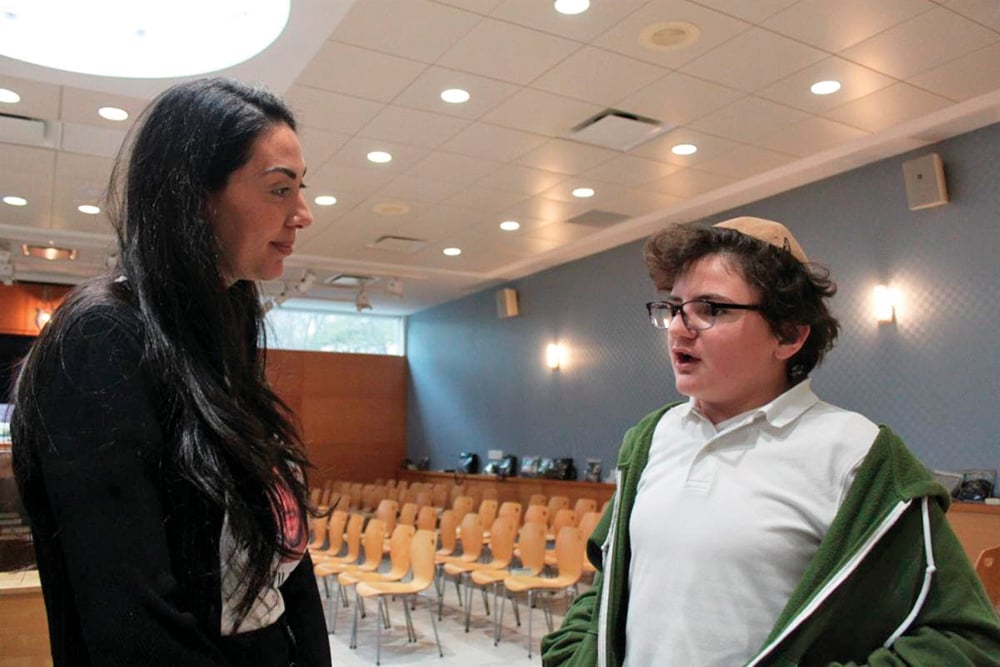I am here going to summarize an article by Rabbi Jacob Schacter that appeared in Tradition in 2008 (41:2): “Holocaust Commemoration and Tisha B’Av: The Debate Over ‘Yom HaShoah.’”
The starting point in Rabbi Schacter’s article is what happened at a visit by Rabbi Yitzchak Herzog to Rabbi Yitzchak Zeev Soloveitchik (“the Griz”) in late 1942. The Griz (son of Rabbi Chaim Soloveitchik) had recently escaped from Europe and settled in Jerusalem. R. Herzog inquired whether the Griz would support the establishment of a one-time “yom evel” for the tragedy that was going on in Europe.
The Griz opposed Rabbi Herzog’s initiative. He based his objection on a passage in a Tisha B’Av kinah from the late 11th or early 12th century, “Mi yiten roshi mayim,” which described the devastation of the communities of Speyer, Worms and Mainz, in 1096. This kinah has the statement: “ein lehosif moed shever vetavera—we cannot add a (new) day (of mourning) over ruin and conflagration,” (ArtScroll, page 275). The author of the kinah makes this statement to explain why we are mourning on Tisha B’Av, and not on the dates of the destruction of those communities.
(The ArtScroll edition has much interesting background on this kinah and cites a similar statement by Pseudo-Rashi at Chronicles 2, 35:25. Regarding the original text of the kinah, see number six in Rabbi Schacter’s article where he concludes that the “ein lehosif” statement was probably in the original text.)
Rabbi Schacter then makes many observations:
Did the author of this kinah really intend to prohibit any new days of commemorative fasting for tragedies for all time?
There is evidence that a permanent fast day was established in both Worms and Mainz to commemorate the destructions in 1096, on the specific dates of these destructions.
There is a tradition that Rabbi Tam established a permanent fast day on the 20th of Sivan to commemorate the burning of over 30 Jews in Blois, in 1171, on that date.
At the time of their meeting, Rabbi Herzog was only suggesting the establishment of a temporary fast day. Temporary fast days have deep roots in Jewish tradition.
Since when does a statement in a kinah serve as a binding halachic source?
Despite the position of the Griz, Rabbi Herzog felt that the establishment of a permanent fast day to commemorate the Holocaust was permitted. But in a letter of Jan. 1, 1945, he wrote that he was not willing to go ahead yet and establish one. He reasoned: “who knows, maybe that which occurred to us is ‘chevlei Mashiach.’ Therefore, we should postpone the proposal until after the war.” (He never came back to the issue again.)
Rabbi Schacter points out that the opposition of the Griz was to the establishment of a fast day. Nothing was mentioned by the Griz in opposition to a new day of commemoration which lacked a fast or other mandated ritual behavior.
——
After the war, the issue changed from establishing a temporary fast day to the issue of establishing some type of permanent day to commemorate the tragedy of the Holocaust.
Various proposals were made to link the Holocaust commemoration with Tishah B’Av, but they were not accepted. Rather, in 1951, the 27th of Nissan was designated by the Knesset as the day to commemorate the Holocaust. Not a single event occurred on this day that made it an appropriate choice. Rabbi Schacter explains: “Some are under the mistaken impression that it marks the anniversary of the beginning of the Warsaw Ghetto Uprising, but that occurred on Erev Pesach, 14 Nisan. But, for various reasons (primarily as a political compromise between those who insisted that it be on or near the day of the beginning of the Warsaw Ghetto Uprising and those who insisted that it not be on Pesach and preferably, not even in the month of Nisan), it was so designated … ”
Now the question is what should be the attitude of the traditional community to this day—a day of commemoration—devoid of required religious practices.
(The initial 1951 law did not mandate how to commemorate the day. Some modifications were made to the law in 1959 and 1961.)
Here are some of the rationales offered by segments of the traditional community in opposition to the establishment of Yom HaShoah:
- The Holocaust is not that unique. It is part of the same category of tragedies that includes the destruction of both Temples, the Crusades, and all other Jewish tragedies. All are to be commemorated on Tisha B’Av.
- It is inappropriate for reasons of halacha to commemorate the Holocaust in Nisan. E.g., the Tachanun prayer is not recited for the entire month of Nisan. See Orach Chayim 429 (2).
- Yom HaShoah is nothing more than the invention of the secular Zionist Knesset. It has no religious significance.
- The official name of the day is: “Yom HaShoah veHaGevurah.” This is offensive because it stresses armed resistance over more spiritual forms of heroism. (This was the name for the day given in 1959. It was modified slightly in 1961.)
- The day’s close proximity to Israel’s Independence Day gives the offensive impression that the Holocaust was a necessary prelude to the founding of the state of Israel.
- No once a year commemoration is necessary for a community that commemorates the Holocaust through Torah study and daily observance of mitzvot.
- The customs of commemoration that have arisen are imitations of goyishe practices.
- The aversion to new days of mourning expressed in the kinah, “Mi yiten roshi mayim.”
- Rabbi Schacter points out another consideration. In order to avoid the theological challenge posed by the Holocaust, it is much easier psychologically to subsume it into previously established archetypes, allowing whatever “explanation” given to them to apply to it as well. E.g., the Holocaust is a “punishment” for the sins of the Jewish people, just as all calamities visited upon the Jewish people are due to its sins.
Rabbi Joseph Ber Soloveitchik agreed with the view of his uncle. The inclusion in the kinot of Tisha B’Av of kinot related to the exile of the 10 tribes, the murder of the 10 martyrs, the 11th century Crusades and the burning of wagon loads of books in France in the 13th century, shows that Tisha B’Av was meant to be the day commemorating all Jewish tragedies. Rabbi Schacter also notes that Rabbi Moshe Feinstein took this same position in 1982.
Rabbi Schacter remembers that on Tisha B’Av, the rav voiced his opposition to a new day almost every year when he got to “Mi yiten roshi mayim,” citing the passage mentioned earlier.
(Rabbi Soloveitchik also opposed the writing of new kinot for the Holocaust. I am omitting Rabbi Schacter’s interesting discussion of that issue.)
In the summer of 1977, Prime Minister Begin met with Rabbi Soloveitchik and discussed the issue. Shortly thereafter, Begin announced that he would move the observance of Yom HaShoah to Tisha B’Av. But there was strong opposition to the proposal and it never got off the ground. Some of the arguments against the proposal: Tisha B’Av would be swallowed up by Yom HaShoah, and Yom HaShoah would be swallowed up by Tisha B’Av.
——
Rabbi Schacter concludes with the observation that he is not satisfied with the present situation and not optimistic. On Tisha B’Av, there is inadequate mourning for the Holocaust. The Holocaust has indeed been swallowed up by Tisha B’Av. On the other hand, on the 27th of Nisan, there is no religiously mandated ritual, and he fears the day will lose its significance after the survivors and their children and grandchildren are gone.
Mitchell First can be reached at [email protected].













